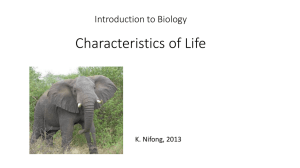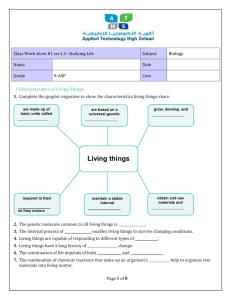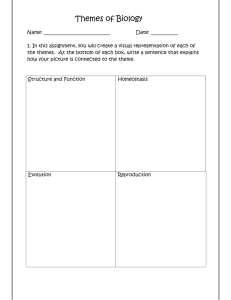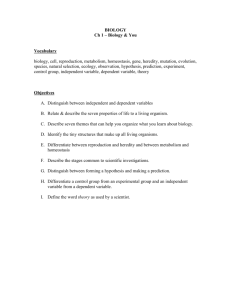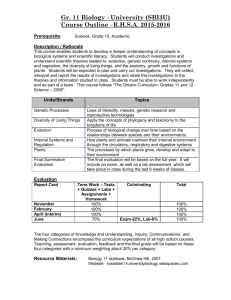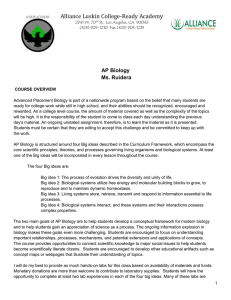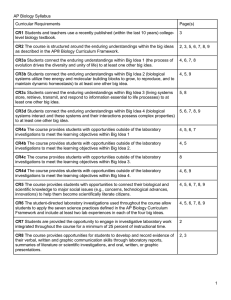Syllabus - Mentz AP Biology
advertisement
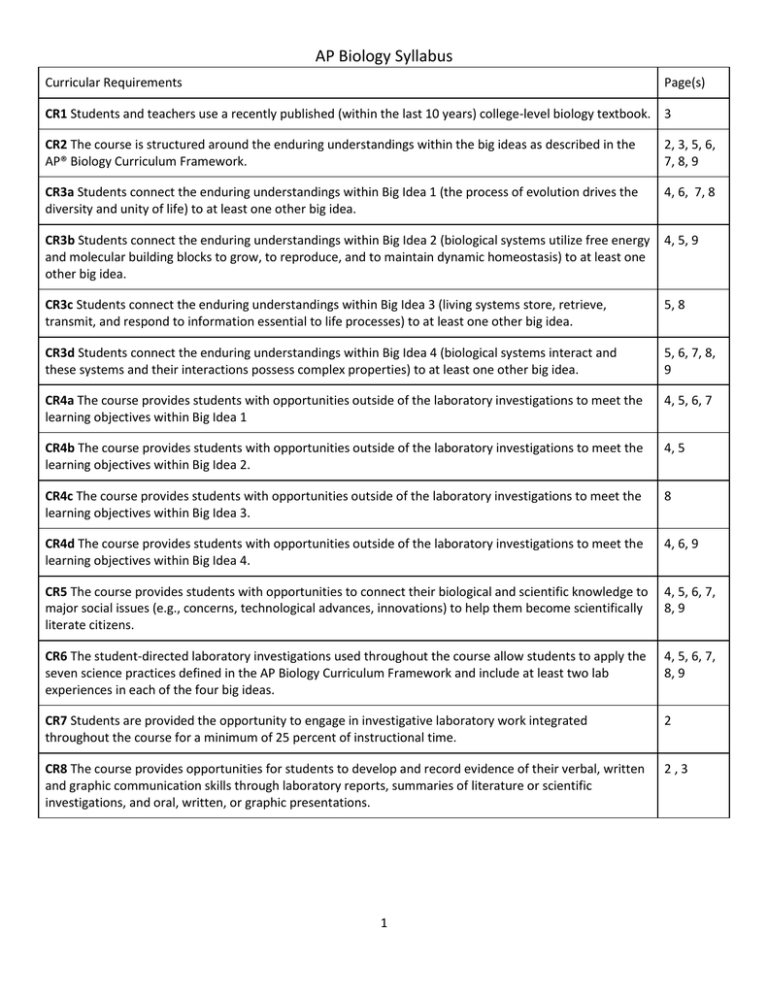
AP Biology Syllabus
Curricular Requirements
Page(s)
CR1 Students and teachers use a recently published (within the last 10 years) college-level biology textbook. 3
CR2 The course is structured around the enduring understandings within the big ideas as described in the
AP® Biology Curriculum Framework.
2, 3, 5, 6,
7, 8, 9
CR3a Students connect the enduring understandings within Big Idea 1 (the process of evolution drives the
diversity and unity of life) to at least one other big idea.
4, 6, 7, 8
CR3b Students connect the enduring understandings within Big Idea 2 (biological systems utilize free energy
and molecular building blocks to grow, to reproduce, and to maintain dynamic homeostasis) to at least one
other big idea.
4, 5, 9
CR3c Students connect the enduring understandings within Big Idea 3 (living systems store, retrieve,
transmit, and respond to information essential to life processes) to at least one other big idea.
5, 8
CR3d Students connect the enduring understandings within Big Idea 4 (biological systems interact and
these systems and their interactions possess complex properties) to at least one other big idea.
5, 6, 7, 8,
9
CR4a The course provides students with opportunities outside of the laboratory investigations to meet the
learning objectives within Big Idea 1
4, 5, 6, 7
CR4b The course provides students with opportunities outside of the laboratory investigations to meet the
learning objectives within Big Idea 2.
4, 5
CR4c The course provides students with opportunities outside of the laboratory investigations to meet the
learning objectives within Big Idea 3.
8
CR4d The course provides students with opportunities outside of the laboratory investigations to meet the
learning objectives within Big Idea 4.
4, 6, 9
CR5 The course provides students with opportunities to connect their biological and scientific knowledge to
major social issues (e.g., concerns, technological advances, innovations) to help them become scientifically
literate citizens.
4, 5, 6, 7,
8, 9
CR6 The student-directed laboratory investigations used throughout the course allow students to apply the
seven science practices defined in the AP Biology Curriculum Framework and include at least two lab
experiences in each of the four big ideas.
4, 5, 6, 7,
8, 9
CR7 Students are provided the opportunity to engage in investigative laboratory work integrated
throughout the course for a minimum of 25 percent of instructional time.
2
CR8 The course provides opportunities for students to develop and record evidence of their verbal, written
and graphic communication skills through laboratory reports, summaries of literature or scientific
investigations, and oral, written, or graphic presentations.
2,3
1
AP Biology
Course Overview
Advance Placement Biology is part of a nationwide program based on the belief that many students are ready for college
work while still in high school, and their abilities should be recognized, encouraged and rewarded. As a college level
course, the amount of material covered, as well as the complexity of the topics, will be high. It is the responsibility of
the student to come to class each day having understanding of the previous day’s material. An ongoing unstated
assignment, therefore, is to learn the material as it is presented. Students must be certain that they are willing to accept
this challenge and be committed to keep up with the course work.
Instructional Context
AP Biology is a course available to juniors and seniors that have completed a full year of biology or honors biology and a
full year of chemistry or honors chemistry. Some students have completed AP Chemistry.
Class is held 5 days per week and each class is two 44 minute periods for a total of 88 minutes/day.
AP Biology Content
AP Biology is structured around four Big Ideas described in the Curriculum Framework. These encompass the core
scientific principles, theories, and processes governing living organisms and biological systems. At least one of the Big
Ideas will be incorporated in every lesson throughout the course.
The four Big Ideas are:
1) The process of evolution drives the diversity and unity of life.
2) Biological systems utilize free energy and molecular building blocks to grow, to reproduce and to
maintain dynamic homeostasis.
3) Living systems store, retrieve, transmit and respond to information essential to life processes.
4) Biological systems interact, and these systems and their interactions possess complex properties.
Class discussions may be based on animations from various sources (textbook, CD’s, internet, etc.) to help the students
visualize what they have read. Quizzes are interspersed throughout the unit and inform how instruction may need to be
adjusted to improve student learning.
The two goals of AP Biology are to help students develop a conceptual framework for modern biology and to help
students gain an appreciation of science as a process. The ongoing information explosion in biology makes these goals
even more challenging. Students are encouraged to focus on understanding important relationships, processes,
mechanisms, and potential extensions and applications of concepts. The course provides opportunities to connect
scientific knowledge to major social issues to help students become scientifically literate citizens. [CR 5]
Hands-on labs will constitute at least 25% of instructional time [CR 7]. Students will have the opportunity to complete at
least two lab experiences in each of the four big ideas. [CR 6] Many of these labs are inquiry based, and emphasize
collaboration, development of hypotheses, data collection, analysis and presentation. Students will maintain a
laboratory notebook that documents their investigations throughout the year. In addition to the lab notebook, a final
reflective essay will be required. [CR 8]
2
Science Practices
Students are required to keep a lab notebook and/or write summaries of observations.
1) The student can use representations and models to communicate scientific phenomena and solve scientific
problems.
2) The student can use mathematics appropriately.
3) The student can engage in scientific questioning to extend thinking or to guide investigations within the
context of the AP course.
4) The student can plan and implement data collection strategies appropriate to a particular scientific
question.
5) The student can perform data analysis and evaluation of evidence.
6) The student can work with scientific explanations and theories.
7) The student is able to connect and relate knowledge across various scales, concepts, and representations in
and across domains.
Textbook and Resources
Biology, 8th Edition, Campbell [CR 8]
AP Biology Investigative Labs: An inquiry-Based Approach, The College Board, 2012
Various Websites
Course Schedule
Unit 1: The Nature of Science and the Chemistry of Life [CR 2]
~ 3 weeks
Readings: Chapters 1, 2, 3, 4, 5, 8
Big Idea 1 is tied to Big Idea 4 in this introductory unit, the complexity of life, properties of living organisms and how
evolution is the unifying theory of biology.
Overview of Topics
Scientific method and experimental design
Explain what is meant by scientific theory
Practice with data collection, analysis, and presentation
Address problems in research, such as confirmation bias
Emphasis on evidence collecting, why evolution is considered a unifying theory
Identify basic elements of living organisms
Describe water’s unique properties
Describe the structure of organic compounds
Understand the pH scale, redox reactions, and hydrolysis/condensation
Apply the laws of thermodynamics to biological systems
Explain how life maintains a high degree of organization
Investigate enzyme structure and function
3
Activities
1) Design and conduct an experiment, create and revise hypotheses, organize data, present findings (SP)
2) Lead class discussion on experimental design by explaining the design process and identifying controls and
variables (SP)
3) Conduct an experiment to determine the optimal pH and temperature of the enzyme catalase [CR 4d]
4) Develop concept maps and diagrams comparing protostomes and deuterostomes to gain an understanding of
how taxonomy helps manage the diversity of life. [CR 8]
5) Participate in discussion where students submit a recent news article for discussion on techniques used, and
implications for science and society [CR 5]
Unit 2: Cellular Processes [CR 2]
~4 weeks
Big Idea 2 is addressed in this unit and tied to Big Idea 1 with regard to the diversity of life.
Big Idea 2 is also tied to Big Idea 4 in showing how complex processes maintain homeostasis.
Readings: Chapters 6, 7, 9, 10
Overview of Topics
Review basic cellular components, construct models comparing differences between prokaryote, eukaryote,
animal, and plant cells
Explain the concepts of selectively permeable as it applies to the cell membrane, distinguish between active and
passive transport
Define homeostasis and illustrate how transport is used to maintain an internal environment
Understand the process by which the cell theory was developed
Understand the Endosymbiosis theory and its connection to evolution [CR 3A] and [CR 3B]
Understand the role of photosynthesis and cellular respiration in maintaining homeostasis
Unit 2 Activities
1)
2)
3)
4)
5)
6)
7)
Diffusion and Osmosis Lab [CR 6]
Create cell models using post-it notes [CR 4B]
Microscopy Lab: Comparing Plant and Animal Cells [CR 6]
Cellular Respiration Lab (Connects Big Idea 2 to Big Idea 4) [CR 3B] and [CR 3D]
Photosynthesis Lab [CR 6]
Transpiration Lab (connects Big Idea 2 to Big Idea 4) [CR 3B] and [CR 3D]
Group Presentations on Membrane Transport
Student constructs models connecting the movement of molecules across membranes; completed as a
presentation to the class, groups assigned a type of transport [CR 4B]
8) Discussion of the Endosymbiosis Theory which includes a summary essay [CR 3B] and [CR4B]
Unit 3: Evolution and Phylogeny [CR 2]
~ 3 weeks
Big Ideas: 1, 3, 4
Readings: Chapters 22, 23, 24, 25
4
Enduring Understandings
1A Change in the genetic makeup of a population over time is evolution.
1B Organisms are linked by lines of descent from common ancestry.
1C Life continues to evolve within a changing environment.
1D The origin of living systems is explained by natural processes.
3A Heritable information provides for continuity of life.
3C The processing of genetic information is imperfect and is a source of genetic variation.
4C Naturally occurring diversity among and between components within biological systems affects
interactions with the environment.
Overview of Topics
How natural selection serves as a mechanism for evolution
Scientific evidence supporting evolution
Hardy-Weinberg equilibrium
Origin of Life, Fossil Records, Concepts of speciation
Current event in evolution, resistance to antibiotics, pesticides, artificial selection
Activities
1) Evolution of Grabbers – simulation, mutations and selection strength (Connects Big Idea 1 to Big Idea 3 and {CR
3C] to Big Ideas 1 and 4
2) Sex and the Single Guppy – laboratory simulation where students explore sexual selection (Connects Big Idea 1
to Big Idea 3) [CR 3A] and [CR 3C]
3) Discussion on how evolution relates to current science and biotechnology [CR 5]
Learning objective 1.5: Student is able to connect evolutionary changes in a population over time to change in
the environment by obtaining news articles and providing a summary and leading a class discussion [CR 4A]
4) Concept map on Evolution showing the processes that lead to its establishment as a theory. Uses PBS videos
“Darwin’s Dangerous Idea” and “What Darwin Never Knew.” [CR 4A]
5) Construct a cladogram and phylogenic tree. [CR 4A]
6) Reconstruct a fossil record to further understand geologic time and extinction. [CR 4A]
Unit 4: Organism Form and Function [CR 2] ~ 2 weeks
Big Ideas 1, 2, 4
Readings: Chapters 40, 41, 42, 44. 45
In this unit, comparative anatomy is strongly emphasized and includes the dissection of athe rat as a comparison
to human anatomy. Big Idea 1 is tied to Big Idea 4 as comparative anatomy emphasizes the relationships
between organisms and similarities that imply common descent. [CR 3A] and [CR 3D]
Enduring Understandings
1B Organisms are linked by lines of descent from common ancestry.
2A Growth, reproduction and maintenance of the organization of living system; require free energy and matter.
5
2C Organisms use feedback mechanisms to regulate growth and reproduction and to maintain environment.
2D Growth and dynamic homeostasis of a biological system are influenced by changes in the system’s
environment.
2E Many biological processes involved in growth, reproduction and dynamic homeostasis include temporal
regulation and coordination.
3E Transmission of information results in changes within and between biological systems.
4A Interactions within biological systems lead to complex properties.
Overview of Topics
Feedback control lops in animals
Thermoregulation in animals
Energy allocation and use in animals
Examples of functioning units in mammal systems (alveoli in lungs, mephrons in kidneys)
Structure and function in body systems (nervous, digestive, skeletak, urinary)
Advances in medicine [CR 4C] and [CR 5]
Activities
1)
2)
3)
4)
5)
Dissection of the rat and comparative anatomy [CR 6]
Exploration of the kidney [CR 4D]
Dissection of a sheep brain, virtual exploration of a human brain [CR 4A]
Comparing rat, horse and human skeletons
Daphnia lab [CR 6]
Unit 5: Pathology [CR 2]
~ 4 weeks
Big Ideas; 1, 2, 4
Readings: Chapters 19, 27, 28, 43
Enduring Understandings
1C Life continues to evolve within a changing environment.
2B Growth, reproduction and dynamic homeostasis require that cells create and maintain internal
environments that are different from their external environments.
4B Competition and cooperation are important aspects of biological systems.
4C Naturally occurring diversity among and between components with biological systems affects
interactions with the environment.
Overview of Topics
Anatomy of Bacteria
Diseases caused by Viruses, Protists, and Bacteria
Viral and Bacterial Evolution
Vaccines and Antibiotics
Social issues and disease transmission [CR 5]
6
Activities
1) Bacteria Lab with Gram Stains [CR 5]
2) Group presentation on a Pathogen [CR 8] which includes final essay on emerging diseases, pathogens
and their hosts. This connects Big Idea 4 (interactions) and enduring understanding 4B (competition) to
Big Idea 1 (evolution) [CR 3D] and [CR 3A
3) HIV and immunology; how to find a cure for a rapidly evolving virus [CR 4A]
Ties Big Idea 1 to Big Idea 4 [CR 3D] and [CR 3A]
Unit 6: Inheritance [CR 2]
~ 4 weeks
Big Ideas 1, 2, 3, 4
Readings: Chapters 12, 13, 14, 15
Enduring Understandings
3A Heritable information provides for continuity of life
3B Expression of genetic information involves cellular and molecular mechanisms.
3C The processing of genetic information is imperfect and is a source of genetic variation.
3D Cells communicate by generating, transmitting and receiving chemical signals.
4C Naturally occurring diversity among and between components within biological systems affects
interactions with the environment.
Overview of Topics
Mitosis, Meiosis and the Cell Cycle
What is cancer?
Mendelian genetics (Laws of Segregation, Independent Assortment, Dominance)
Mathematical predictions (Punnett squares) and Chi Square Analysis
Chromosomal Patterns of Inheritance (sex linkage)
Human Genetic Disorders
Activities
1)
2)
3)
4)
5)
6)
7)
Modeling of the Cell Cycle [CR 4C]
Microscope observations of mitosis and meiosis [CR 6]
Fruit fly lab [CR 6]
Dihybrid Corn with Chi Square analysis [CR 6]
Practice genetic problems [CR 4C]
Hardy-Weinberg problem set: survey of human traits [CR 4C]
Chromosome Simulation – using beads and pipe cleaners, demonstrate linkage groups and inheritance
patterns [CR 4C]
8) Genetic Disorders Presentation [CR 4C]
7
Unit 7: Molecular Genetics [CR 2]
~ 3 weeks
Big Ideas: 1, 2, 3, 4
Readings: Chapters 16, 17, 18, 20
Enduring Understandings
1A Change in the genetic makeup of a population over time is evolution.
2C Organisms use feedback mechanisms to regulate growth and reproduction and to maintain
dynamic homeostasis.
2E Many biological processes involved in growth, reproduction and dynamic homeostasis include
temporal regulation and coordination.
3A Heritable information provides for continuity of life.
3B Expression of genetic information involves cellular and molecular mechanisms.
3C The processing of genetic information is imperfect and is a source of genetic variation.
4A Interactions within biological systems lead to complex properties.
Overview of Topics
DNA is the genetic material (historical experiments, DNA structure and function, DNA replication)
Flow of genetic information (genetic code, role of other polymers, transcription, translation)
Mutations
Gene expression (operon systems in prokaryotes, eukaryotic gene expression)
Restriction enzymes, plasmids, transformation
DNA technology (how gel electrophoresis works and applications of this technology)
[CR 5]
Biotechnology: stem cells, synthetic biology, genetically modified foods [CR 5]
Activities
1)
2)
3)
4)
5)
6)
Recombinant DNA simulation [CR 4C]
Bacterial Transformation [CR 6] – Also ties Big Idea 3 to Big Idea 1 [CR 3A] and [CR 3C]
DNA Concept Map [CR 4C]
DNA Modeling, showing transcription and translation [CR 4C]
Gel Electrophoresis [CR 6]
Class discussions on biotechnology, student led discussions [CR 5]
Unit 8: Ecology and Bioethics [CR 2] ~ 4 weeks
Big Ideas 1, 2, 3, 4
8
Readings: Chapters 52-56 and selected articles chosen by students
Enduring Understandings
1A Change in the genetic makeup of a population over time is evolution.
1C Life continues to evolve within a changing environment.
2A Growth, reproduction and maintenance of the organization of living systems requires free energy
and matter.
2C Organisms use feedback mechanisms to regulate growth, reproduction and dynamic homeostasis.
2D Growth and dynamic homeostasis of a biological system are influenced by changes in the system’s
environment.
2E Many biological processes involved in growth, reproduction and dynamic homeostasis include
temporal regulation and coordination.
3E Transmission of information results in changes within and between biological systems.
4A Interactions within biological systems lead to complex properties.
4B Competition and cooperation are important aspects of biological systems.
4C Naturally occurring diversity among and between components within biological systems affects
interactions with the environment.
Overview of Topics
Populations and Communities
Population growth models
Biodiversity and sustainability
Biomes and Ecosystems
Energy flow and chemical cycling
Primary productivity
Activities
1) Biome Project – student presents a biome, discussing its characteristics and challenges [CR 5]
2) Student led discussions on environmental topics; students share relevant articles and lead class
discussions [CR 5]
3) Dissolved oxygen and Primary Productivity Lab [CR 6]
4) Human Demography study calculating birth and death rates [CR 4D]
5) Animal Behavior lab [CR 6]
6) Dandelion Population Lab – outdoor survey and mathematical analysis
Learning Objective 4.19 The student is able to use data analysis to refine observations and measurements
regarding the effect of population interactions on patterns of species distribution and abundance.
9
Science Practices Matrix for Major Labs
SP 1
Use
representations
and models
Scientific
Method, Crickets
SP 2
SP 3
SP 4
SP 5
SP 6
SP 7
Use
mathematics
Engage in
scientific
questioning
Plan and
implement
data collection
strategies
Perform data
analysis and
evaluation of
evidence
Work with
scientific
explanations /
theories
Connect and
relate
knowledge
X
X
X
X
X
X
X
X
X
X
X
X
X
X
X
X
X
X
X
X
X
X
X
X
X
X
X
X
X
X
X
Enzyme Lab
Osmosis and
Diffusion
X
X
Chromatography
Transpiration
Cellular
Respiration
X
X
X
Microscopy Lab
X
X
X
Sex and the
Single Guppy
X
X
X
X
X
X
X
X
X
Daphnia Lab
X
Dissection
X
X
Microbiology Lab
X
X
X
Fruit Fly Lab
X
X
X
Hardy Weinberg
Activity
X
X
Gel
Electrophoresis
DNA Simulations
X
X
X
X
X
X
X
X
X
X
X
X
X
X
X
X
X
X
X
X
X
X
X
X
X
X
Animal Behavior
Populations
Studies
X
X
X
X
X
X
X
X
X
X
X
X
X
10
